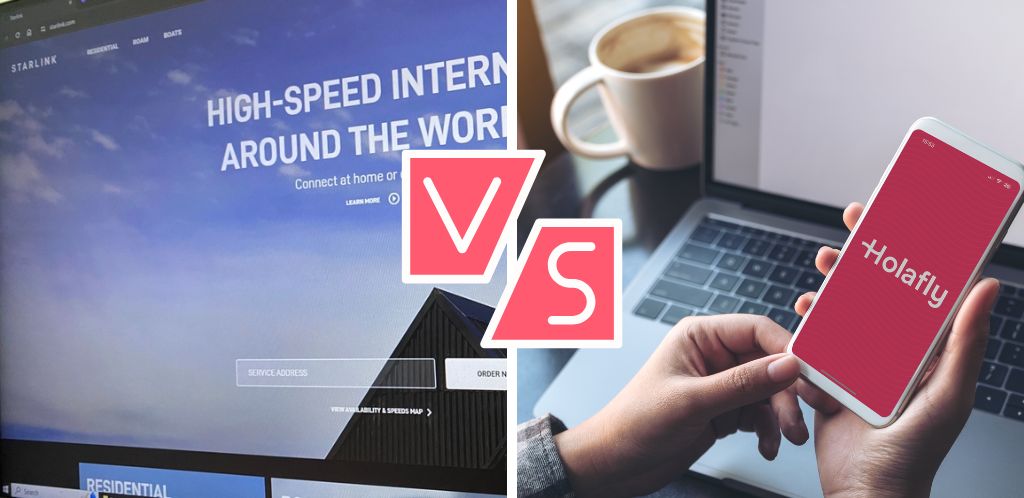Starlink Roam vs Holafly Plans: Which is best for you
Need to stay connected? We compare two of the most popular global internet services: Starlink Roam vs. Holafly Plans.
Looking for a way to stay connected while you travel? Today, we’re breaking down the differences between two of the most popular global internet services. Let’s compare Starlink Roam and Holafly Plans to see what each has to offer.
While both options promise reliable connectivity, they’re designed for different types of users and lifestyles. So, how do you know which one’s right for you? In this comparison, we’ll break down pricing, plans, coverage, stability, and ease of use. Stick with us to find out which one comes out on top.
Comparison summary: Starlink Roam vs. Holafly Plans
Before diving into a detailed breakdown, it’s best to start with a clear overview of the key differences. That way, you’ll have a solid sense of what each one brings to the table.
Starlink Roam and Holafly Plans both offer global connectivity but they go about it in very different ways. Starlink relies on satellite internet to reach remote areas, while Holafly Plans focuses on eSIMs that give you instant access wherever there’s mobile coverage. Let’s take a closer look.
| Features | Holafly Plans | Starlink Roam |
| Price (unlimited plan) | $67.90 | $78.00 month |
| Unlimited data | Yes | Yes |
| Requires antenna | No | Yes |
| Works on the move | Yes | Yes |
| Requires power source | No | Yes |
| Power consumption | Low (5W) | Medium (30-150W) |
| Coverage | 170+ countries | More than 40 countries |
| Ocean use | No | No |
| Extended stay | Yes | No (max. 3 months) |
| Cancel anytime | Yes | Yes |
| Recommended locations for use | Cities, towns and surrounding areas | Areas without 4G/5G coverage |
| Speeds | 40-180 Mbps | 30-120 Mbps |
| Speed reduction due to rain | Minimal | Moderate |
| Requires clear sky | No | Yes |
| Latency | 30-50 milliseconds | 25-60 milliseconds |
| Automatic monthly renewal | Yes | Yes |
| Online activation of the service | Yes | No (requires physical antenna) |
What is Holafly Plans?
Holafly Plans is a global internet service that uses eSIM technology to provide reliable, uninterrupted connectivity in over 170 countries. It’s built for digital nomads, remote workers, and frequent travelers who need to stay connected no matter where they are.
Its main features include:
- Monthly data plans: To suit different connectivity needs, Holafly Plans offers flexible plans with options for unlimited data, 25GB, or 10GB. All plans renew automatically but can be adjusted or canceled at any time.
- Global coverage: It lets you stay connected across multiple countries without swapping SIM cards or worrying about roaming charges. Plus, you get to keep your regular phone number!
- Easy activation: Simply download and activate the eSIM from the compatible device, without complicated configurations or the need for additional equipment.
Holafly Plans makes mobile connectivity simple with a user-friendly, accessible solution built for the demands of modern travel. If you need a steady, reliable connection on the go, this might be exactly what you’re looking for.
Important: If you are a frequent traveler and want to stay connected without worrying about expensive roaming or looking for a new SIM at every destination, Holafly’s subscription plans are for you. With a single eSIM, enjoy internet in more than 170 countries for a fixed price and no surprises on your bill. Travel without limits and connect easily and securely! 🚀🌍

What is Starlink Roam?
Starlink Roam is a satellite internet service developed by SpaceX, designed to keep you connected in places where traditional networks can’t reach. It’s ideal for frequent travelers, remote professionals, and anyone living in rural or off-grid areas with limited or no ground-based internet infrastructure.
Among its main features are:
- Global connection: Works thanks to a network of low orbit satellites, allowing internet access virtually anywhere with clear skies.
- Unlimited data: It offers unlimited data plans, perfect for bandwidth-heavy tasks like video calls or streaming content.
- Equipment options: It works with various antenna kits, including the Starlink Mini Kit designed for mobility, and the standard motorized antenna made for moving vehicles like RVs or boats.
- Competitive speeds: Offers download speeds ranging from 50 to 200 Mbps, depending on location and weather conditions.
Starlink Roam stands out for its ability to keep users connected in the toughest environments. It’s a premium solution for those who need reliable internet where 4G or 5G networks just can’t reach.

First use: Holafly Plans vs. Starlink Roam
Now that we’ve covered both options, let’s take a closer look at how they differ. Ease of setup is definitely a key factor when choosing a connectivity service. It’s worth noting that Holafly Plans and Starlink Roam take very different approaches here, reflecting the needs of their target users. Let’s walk through the activation process for each
Steps to activate Holafly Plans
- Plan purchase: Access the web section and select the plan that best fits your data consumption (10 GB, 25 GB or unlimited).
- Device requirements: Check that your smartphone, tablet or other device is compatible with eSIM.
- eSIM installation: Download the QR code you will receive after purchase and install it directly on your device.
- Service startup: Once the eSIM is installed, activate the plan and start enjoying global connectivity in a matter of minutes.
A major plus is you can buy and activate the service completely online without needing extra gear or tricky setups. It’s designed to get you connected quickly and hassle-free.
Steps to activate Starlink Roam
- Equipment purchase: Buy the Starlink kit (available online or in physical stores), which includes the antenna and router.
- Subscribe to a plan: Choose the data plan that best suits your needs.
- Installing the antenna: Place the equipment in a clear place, with a clear sky, to ensure an optimal connection.
- Power supply: Make sure you have a constant power supply to power the equipment (average consumption of 30 to 150 W).
- Initial setup: Use the Starlink app to align the antenna and complete the configuration.
- Service startup: Once configured, you can start using satellite internet.
Setting up Starlink is a bit trickier than Holafly. You’ll need a good spot for the antenna, a power source, and you’ll have to make sure it’s pointed just right. It definitely takes more time and effort than getting Holafly Plans up and running.
In terms of ease and speed, Holafly Plans clearly has the edge with its fully digital activation. You can get set up in just minutes without needing any extra equipment.
Internet for international travel: Starlink Roam vs. Holafly Plans
Next, let’s look at how these two options perform for international travelers. How hassle-free is it to stay connected as you cross borders? We’ll cover things like user-friendliness during trips, length of coverage, how easy it is to carry the equipment, and how each service suits various travel styles and destinations.
Again, both seek to solve global connectivity needs, but do so in very different ways. Let’s see how:

Holafly Plans: Simplicity and global coverage
Holafly Plans is built to provide hassle-free internet access in over 170 countries. The biggest benefit? No extra equipment needed — just a device that supports eSIM to get high-speed connectivity.
Highlights:
- Ease of transport: No additional hardware required, you only need your mobile device.
- Global coverage: Includes most tourist and urban destinations with 4G and 5G networks.
- Flexibility of stay: You can use it for both short and long stays, renewing the plan automatically every month.
- No technical worries: You manage everything through an app or by using a QR code sent to your email.
Perfect for: Frequent travelers, digital nomads and those who prefer quick and easy solutions.
Starlink Roam: Connectivity anywhere in the world
Starlink Roam is the go-to choice for remote locations or trips to areas with little to no mobile internet coverage. That said, its satellite-based approach does come with some added complexities compared to Holafly Plans.
Highlights:
- Equipment needed: Includes an antenna (such as the Starlink Mini kit) and a Wi-Fi router. Although portable, it requires space and a constant power source.
- Worldwide coverage: Works in areas where mobile networks do not reach, but is not available in some countries due to legal restrictions.
- Stay restrictions: You can use the plans for up to three months per country, which might be inconvenient for longer stays.
- Initial installation: You need to find a clear location for the antenna and this can complicate its use in urban environments.
Perfect for: Expeditions to remote locations, working in rural areas and those who prioritize independence from local networks.
| Holafly Plans | Starlink Roam | |
| Coverage | 170+ countries with 4G/5G networks | Remote areas; limited in countries with legal restrictions |
| Equipment needed | None | Antenna and router |
| Ease of transport | High (only need your device) | Moderate (requires space and constant power) |
| Flexibility of stay | No restrictions; automatic renewals | Maximum of three months per country |
| Perfect for | Frequent travelers, urban and tourist areas | Expeditions to remote locations, work in rural areas |
Once again, it’s clear that these two services cater to different needs when traveling internationally. Holafly Plans shines with its simplicity, portability, and strong coverage in urban and tourist areas. Meanwhile, Starlink Roam offers the advantage of connectivity in remote spots but involves more logistics and a higher upfront investment. Choosing between them really comes down to your travel style and the regions you plan to visit.
Starlink Roam plans and pricing vs. Holafly Plans
Having looked at how these services work for international travel, let’s now focus on what really matters when picking one: the plans and pricing. Is a global eSIM the cheaper option, or does satellite internet justify the higher price? What kind of plans do they each offer, and how much do they actually differ? We’ll break it down in a table to make things clearer.
| Holafly Plans | Starlink Roam | |
| Unlimited plan | $67.90 | $78.00 |
| Other plans available | 25GB: $51.19 – 10GB: $40.93 | 40GB plan: $43.00 |
| Initial equipment cost | None | From $270 |
| Includes antenna or router | Not applicable | No, must be purchased separately |
| Automatic renewal | Yes | Yes |
| Flexible cancellation | Yes | Yes |
As you can see, Holafly Plans and Starlink Roam offer very different approaches and price points. Holafly Plans stands out for its flexibility, with plans ranging from unlimited data to more budget-friendly options like 10GB for $51.19 and 25GB for $40.93.
On the other hand, Starlink Roam offers two plans: an unlimited option and a 50GB plan for $43. The main drawback here is that you have to purchase the antenna separately, which adds to the upfront cost.
Network coverage, speed and stability
Now let’s move on to connection quality. Coverage, speed, and stability can make or break your experience. So, how do Holafly Plans and Starlink Roam perform in different situations? Let’s take a closer look.
| Holafly Plans | Starlink Roam | |
| Coverage | More than 160 countries with 4G/5G networks | Remote areas with clear skies |
| Geographic specialization | Urban and rural areas with mobile networks | Places without terrestrial infrastructure |
| Average speed | 40 – 180 Mbps | 30 – 120 Mbps |
| Average latency | 30 – 50 ms | 25 – 60 ms |
| Weather impact | Minimal | Moderate |
| Stability in motion | High | Medium (alignment dependent) |
Coverage: where can you connect?
Holafly Plans offers excellent coverage in more than 170 countries. This makes it an excellent choice for travelers moving between cities, towns and areas with 4G/5G networks.
Starlink Roam targets a completely different kind of traveler. It’s ideal for staying connected in places where mobile networks don’t reach, like remote countryside, mountains, or deserts. However, even though its coverage is technically global, local regulations can restrict access in certain countries.
Speed and latency: How fast will your internet be?
Holafly Plans typically deliver download speeds between 40 and 180 Mbps, depending on local mobile network conditions. That’s more than enough for video calls, cloud-based work, and streaming in high definition without a hitch.
Starlink Roam offers speeds between 30 and 120 Mbps, which are more than enough for demanding tasks. However, performance can vary depending on factors like where the antenna is placed and the weather conditions.
In terms of latency, both options are competitive: Holafly Plans maintains a range of 30 to 50 milliseconds. Starlink portable varies between 25 and 60 milliseconds.
Stability: Stay connected at all times
Holafly Plans offers solid reliability, especially in cities and areas with strong mobile infrastructure. Since it doesn’t rely on external antennas or specific positioning, it’s a great choice for travelers who are always on the move.
While Starlink Roam is great for remote spots, its connection can be spotty during bad weather or if the antenna isn’t set up just right. Plus, it needs plenty of power (30 tp 150 W) and an open space, which can make it less convenient in certain places.
So, what’s the takeaway from all this? Holafly Plans is the go-to choice if you want simplicity, global coverage, and reliable performance in cities and popular travel spots. Meanwhile, Starlink Roam shines in places without mobile networks, providing a unique solution for those venturing into the world’s most remote corners.
Starlink Roam vs. Holafly Plans, which one to pick?
It’s hard to say which is better without knowing your particular situation. Picking between them depends on what kind of connection you need, the type of trip you’re taking, and the destinations on your itinerary. Both offer smart, reliable options, but they suit different travel styles.

When to choose Holafly Plans?
Holafly Plans is the best choice if you prioritize:
- Immediate and hassle-free connection: No need for antennas or advanced configurations. With an eSIM compatible device, you’ll be connected in minutes.
- Frequent trips to urban and tourist areas: Coverage covers more than 170 countries with 4G/5G networks, great for those exploring cities or well-developed areas.
- Flexibility of use: You can easily activate, cancel, or adjust plans to fit your needs, whether you’re staying for a short trip or a longer stay.
- Constant mobility: This service is perfect for you if you need to move from one place to another without worrying about the stability of the connection.
- Controlled budget: By not requiring additional equipment, such as antennas or routers, it is a more economical and accessible option.
Perfect for: Digital nomads, frequent travelers and those who prefer practical and fast solutions in destinations with mobile infrastructure.
When to opt for Starlink Roam?
Starlink Roam is the right solution if you need:
- Connection in remote areas: Satellite technology guarantees internet access in places without mobile coverage, such as rural, mountainous or desert areas.
- No local mobile networks: If you visit places with little or no telecommunications infrastructure, this service keeps you connected.
- Specialized projects: Perfect for expeditions, field work, research or activities in areas beyond the reach of traditional networks.
Perfect for: Explorers, remote professionals working in remote locations and those who need guaranteed access in any corner of the planet.
As we’ve said, the best choice really depends on what you’ll need during your trip. If you want something simple, easy to use, and budget-friendly, Holafly Plans is a great fit. But if you’re heading into remote areas where regular networks don’t reach, you’ll get the best connectivity with Starlink Roam. It does require a bigger upfront investment and some technical setup, but it’ll keep you connected even in the toughest spots.
Actually, these two services are different but work well together. If you’re planning a trip that mixes big city experiences with adventures in remote areas, it might be best to use both to make sure all your needs are covered.
Frequently asked questions about Starlink Roam vs. Holafly Plans
The main difference lies in how they connect to the internet. Holafly Plans uses eSIM technology to access 4G/5G mobile networks in over 170 countries, all without needing extra equipment. On the other hand, Starlink Roam relies on satellite internet, which is perfect for areas without mobile coverage but does require an antenna and a steady power source.
Holafly Plans is much easier to set up and use. You just need an eSIM-compatible device, scan a QR code, and you’re good to go. In contrast, Starlink Roam requires setting up an antenna in an open area, plugging it into a power source, and configuring it through an app, which can take a bit more time.
If you’re heading to rural areas or spots without mobile coverage, Starlink Roam is your best bet thanks to its satellite connection. But if your destination has mobile networks, Holafly Plans is a more convenient and cost-effective choice.
You’ll need to spend a good amount upfront to get started with Starlink Portable, since you have to buy the antenna and gear. On the other hand, Holafly Plans works right away with no extra devices, making it a more affordable option.
Yes, the portable version of Starlink Roam lets you stay connected on the move as long as the antenna has a clear view of the sky. That said, Holafly Plans is a more convenient choice for those who need a quick, reliable connection wherever they go.
Because Holafly Plans uses local mobile networks, weather usually doesn’t affect it much. Starlink Roam, while generally reliable, can sometimes face interruptions or slower speeds during heavy storms or intense rain.
For trips focused on cities or popular tourist spots with good mobile signals, Holafly Plans is the simplest and most affordable option. But if you’re planning to venture into remote places where mobile service isn’t available, Starlink Portable is your best bet to stay online.





 Language
Language 


















 No results found
No results found










